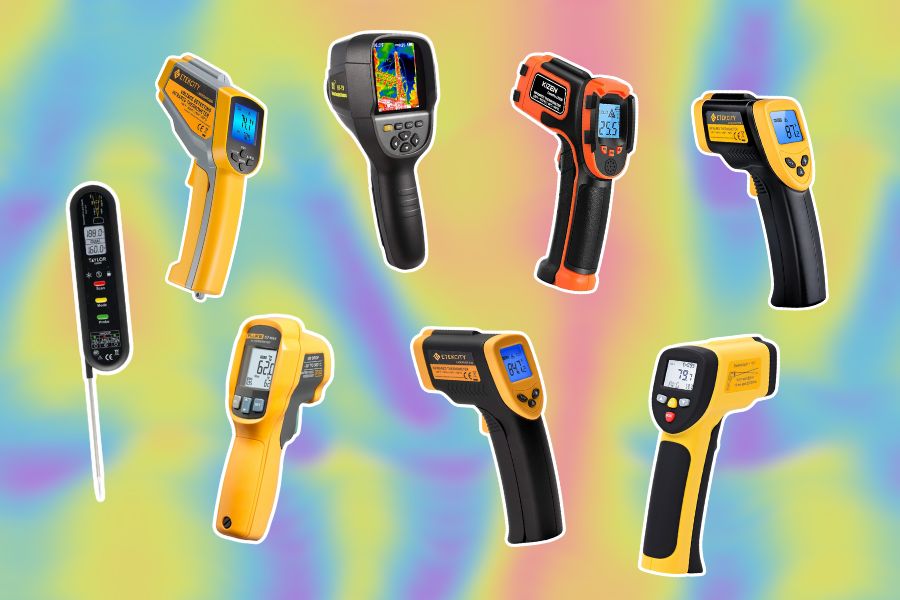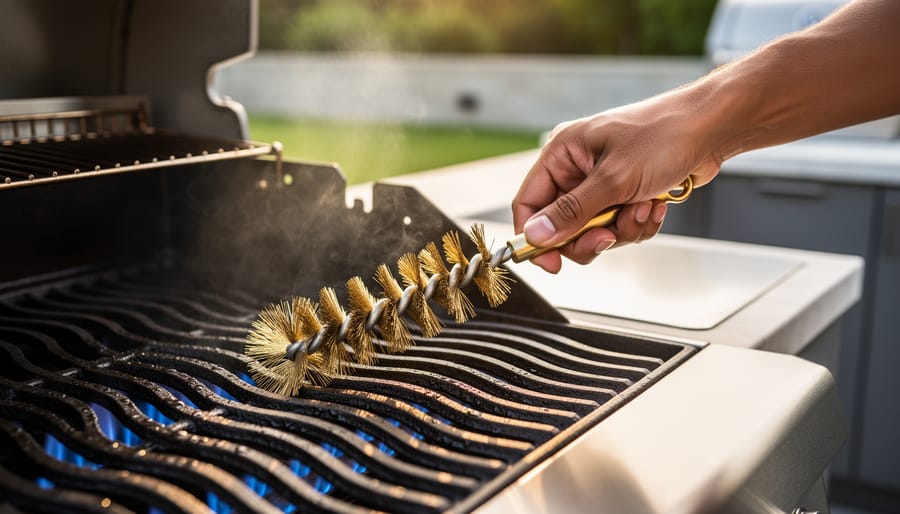The best infrared thermometers allow you to take highly accurate readings from a safe distance over a broad temperature range. Then, having an ergonomic grip, a readable screen, and rapid temperature measurements are the icing on the cake.
Accuracy is vital for any type of measurement, be it temperature or not. Nothing beats reproducible readings. For that reason, the best infrared thermometers are known for accuracy.
Being a non-contact tool for measuring surface temperature, it is important that infrared thermometers maintain accuracy over long distances. As a result, the best infrared thermometer usually has a high distance-to-spot ratio. A high distance-to-spot ratio indicates higher precision when IR thermometers measure temperatures from farther distances.
Then, having a firm, comfortable grip when handling IR thermometers makes a lot of sense. Also, getting temperature readings very fast and being able to read the readings clearly boosts the infrared thermometer gun experience.
Best Infrared Thermometers At a Glance
- Overall Best Infrared Thermometer: Etekcity Infrared Thermometer 1025D
- Lowest Error Margin: Fluke 62 Max Industrial IR Thermometer
- Portable IR Thermometer: Taylor Precision Products Splash-Proof Dual Temperature Infrared/Thermocouple Thermometer
- Rechargeable Laser Infrared Thermometer: Hti-Xintai Higher Resolution 320 x 240 IR Infrared Thermal Imaging Camera
- Ergonomic Grip: Etekcity Infrared Thermometer Temperature Gun for Cooking
- Budget Laser Infrared Thermometer: KIZEN Infrared Thermometer Gun
- Rapid Temperature Reading: Etekcity Infrared Thermometer 774
- Widest Temperature Measuring Range: ennoLogic Temperature Gun
Our Best Infrared Thermometer Reviews
Overall Best Infrared Thermometer: Etekcity Infrared Thermometer 1025D
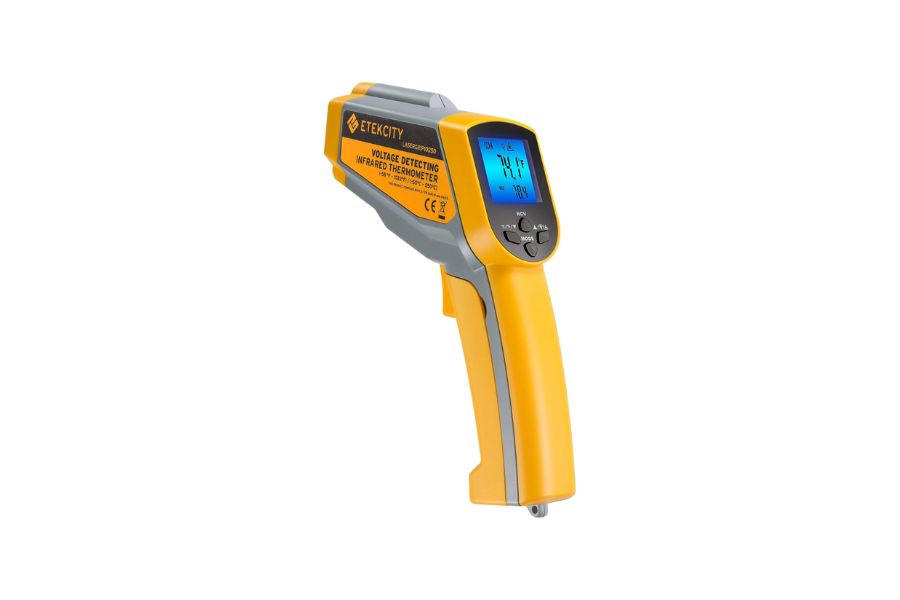
The Etekcity 1025D offers all the best features you’d expect to find in the best infrared thermometer. It has everything from its distance-to-spot ratio to its response time, error margin, and temperature range.
Distance-to-Spot Ratio (D:S ratio)
When it comes to the D:S ratio, this device has some of the best offerings in the market. Its 12:1 is one of the best D:S ratios you’ll find within its price range.
With its D:S ratio, this device allows you to measure the temperature from a 1-inch spot while standing up to 12 inches away. Beyond 12 inches, the accuracy may drop as the measurement spot grows.
Margin of Error
This product has a margin of error of ±2%, which is pretty great. You can certainly be sure that every reading is never 0.02 units of the actual temperature. So, you are almost always getting great results.
While it has a very good margin of error, the Fluke 62 max sometimes ups the Etekcity 1025D when it comes to accuracy. That doesn’t minimize the overall quality of this product, however.
Temperature Range
This device can measure temperatures from around -58 to 1022℉ and -50 to 550℃. Not the highest in our review, but still topnotch. Check out the Etekcity Infrared Thermometer Temperature Gun for Cooking, KIZEN, Etekcity 1080, and ennoLogic if you want wider temperature ranges.
Response Time
With a response time of less than 500ms, this device returns results almost instantaneously. None of the other infrared thermometers offer faster response times.
Emissivity
The 1025D has adjustable emissivity settings. This is good news because it gives you the flexibility to use it on various materials.
Its emissivity range falls between 0.1 and 1.0. So, be it metal, brick, wood, brass, water, or fiberboard, this product can take its measurement.
Usage
The Etekcity 1025D will come in handy for cooking, construction, auto repair, HVAC installation, electrical works, and more. However, it is not suitable for human use.
Unit Switching
Whether you want the result in degrees Celsius or Fahrenheit, this thermometer gun works for you.
Other Features
Besides all we’ve highlighted, the 1025D comes with an LCD backlit display screen. So, you can view the readings under various lighting conditions.
It uses dual lasers, so it is easier to pick a spot on the target object. It also has a voltage tester, if you ever need that extra feature.
Also, an IR thermometer can be helpful for your wood burning stove to measure the heat.
Lowest Error Margin: Fluke 62 Max Industrial IR Thermometer

When it comes to accurate readings, Fluke 62 Max takes the win. But beyond that, it offers a fair D:S ratio, rapid response time, adjustable emissivity, and ergonomic grip.
Distance-to-Spot Ratio
With a D:S ratio of 10:1, this brand offers one of the lowest measurement distances of all the infrared thermometers in this review. But even at that, the ratio is not bad.
You can expect to measure a 1-inch spot from about 10 inches. When you think of it, this should be a good enough distance for many instances where you’ll need to measure surface temperatures.
Margin of Error
With a margin of error of around ±1.5% or 1.5℃ (the higher of the two), the Fluke 62 Max offers us the best accuracy in this review.
By its margin of error, you can always expect that the readings from this infrared temperature gun will never be 1.5 units higher or lower than the actual value.
Temperature Range
While it isn’t the lowest, the range within this IR thermometer measures temperature is not too impressive. The range of 30 – 500℃ (-22 – 932℉) could be better. But that range would suffice under most of the conditions you’ll use.
Response Time
The response time of this device is on par with the Etekcity 1025D, which is pretty impressive. More times than not, you get the temperature readings in less than 500ms.
Emissivity
Thanks to its emissivity being adjustable, this IR thermometer is pretty versatile. You get an emissivity range of 0.1 to 1.0, so you can tune it to suit pretty much any type of material.
Usage
As expected, you can use this device for various purposes, including cooking, electrical work, HVAC repair & installation, mechanical purposes, and more.
But even with its broad application, you should not use it for measuring human body temperature.
Unit Switching
This thermometer only displays results in ℃. So, you may have to do the conversion to ℉ by yourself.
Other Features
With this laser thermometer, you get a large backlit LCD display, which makes result viewing easy in dark and bright conditions. You also get a spectral response between 8 to 14 microns, indicating a fairly high sensitivity.
Portable IR Thermometer: Taylor Precision Products Splash-Proof Dual Temperature Infrared/Thermocouple Thermometer
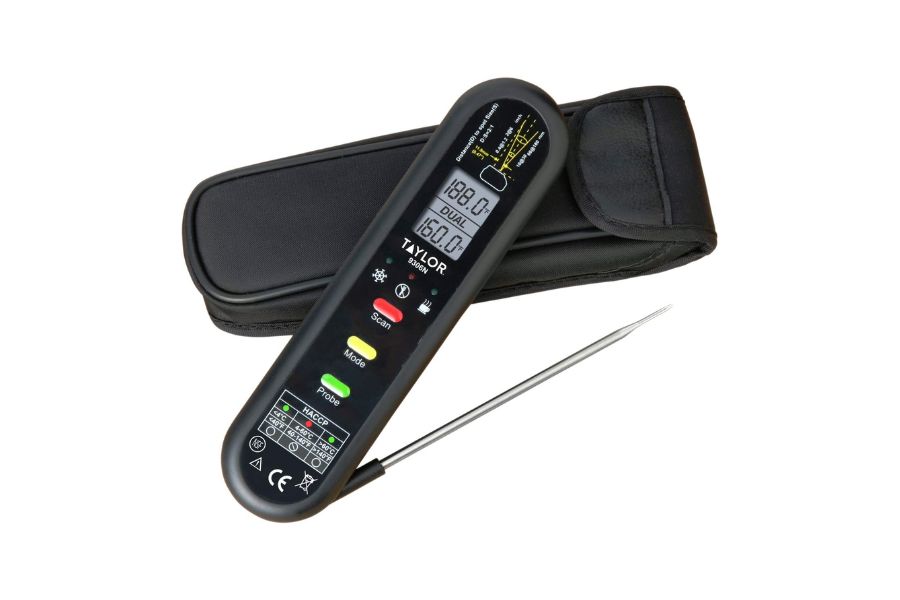
If portability is top of your priority list, this IR thermometer is for you. Weighing just 4.8 ounces and measuring 0.47 inches in length, there’s nothing smaller in this review.
Besides being portable, the Taylor Precision comes with a probe for reading core temperature. It also offers high accuracy, unit switching, and rapid response.
Distance-to-Spot Ratio
With a D:S ratio 3:1, this thermometer offers the lowest measurement distance of all the IR thermometers in our review. But then, considering the fact that it is primarily for cooking, the distance-spot ratio may not be so bad.
In rare instances, being more than 3 inches from the target object is safer.
Margin of Error
Between 32ºF and 149ºF (0ºC and 65ºC), you get a margin of error ± 2℉(1℃), which is fair. But of course, we’ve seen better from some of the other infrared thermometers on our list.
Temperature Range
The range of measurement of this device might be the lowest we reviewed. But then, for cooking, a range of -67º – 482ºF and -55ºC – 250ºC is pretty okay.
Response Time
The response time of the Taylor Precision Products Dual Temperature Thermometer – 500 ms – is pretty okay. It meets the industry standard.
Emissivity
Emissivity is adjustable. So, we know it can work on various materials, making it versatile.
Usage
It is primarily used for cooking.
Unit Switching
When using this, you do not have to manually convert from ℃ to ℉ or vice-versa because it comes with unit switching.
Other Features
Besides being an IR thermometer, this device is also a probe thermometer. The foldable stem by the side measures core temperature using a thermocouple. So, while the others in this review cannot measure food doneness, this one can.
The thermocouple thermometer has a range of -67º – 626ºF and -55ºC – 330ºC. Then, from 14º to 149ºF (-10º to 65ºC), its margin of error is ± 1ºF (0.6ºC) – more than decent.
The thermometer is IP65 rated – a mark of high durability. It also comes with an auto-off feature, which can help preserve battery life.
Rechargeable Laser Infrared Thermometer: Hti-Xintai Higher Resolution 320 x 240 IR Infrared Thermal Imaging Camera
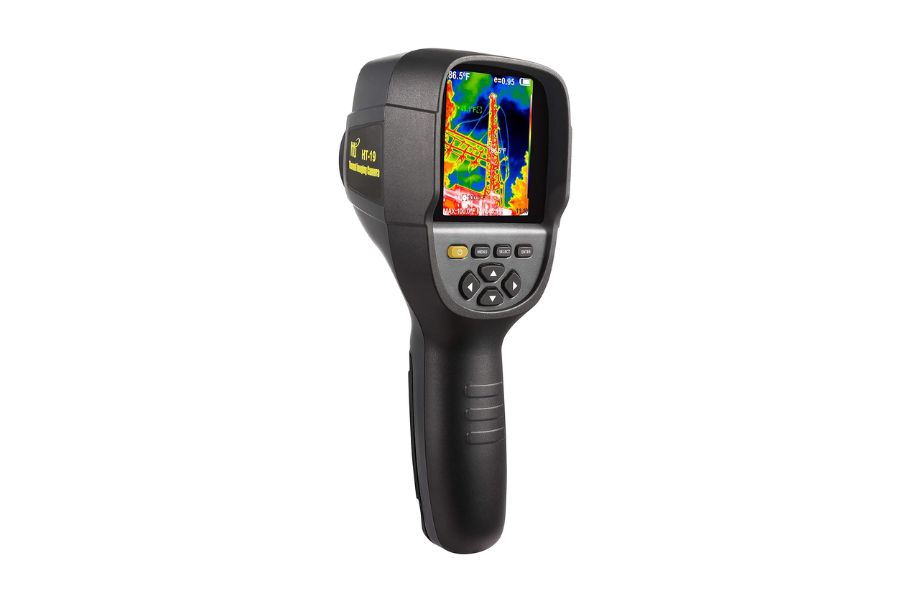
The Hti-Xintai sets itself apart from the rest with its rechargeable battery. But besides being rechargeable, it has a good margin of error, variable emissivity, and unit conversion. So, overall, it is a standard product.
Distance-to-Spot Ratio
With a distance-spot ratio of around 10:1, you can get highly precise measurements when using this device within 10 inches of the target. While this is not bad, it could be better, especially considering the price.
Margin of Error
A ±2% (or ±2℃) margin of error is great; it matches what the best infrared thermometer in our review offers. We reviewed another product with a better margin of error. But we don’t think this product’s margin of error is a dealbreaker.
Temperature Range
Now, there wasn’t much to impress us when it comes to the measuring range. The Hti-Xintai only does the Taylor Precision thermometer with its -4 – 572℉ range.
Response Time
It has an average response time of 500 ms – pretty much the standard.
Emissivity
The emissivity can be adjusted between 0.01 and 1.0 – a broader emissivity range than any of the other IR thermometers we reviewed.
Usage
Unsurprisingly, the broad emissivity range of this product allows usage in pipeline, HVAC, electric, and auto repairs. You may also use it for cooking.
Unit Switching
You can switch between degrees Celsius and Fahrenheit. So, you do not have to do any manual calculations.
Other Features
It has a wavelength range of 8 to 14 microns. As a result, it is highly sensitive to infrared radiation. Then it runs on a rechargeable battery that offers a battery life of around 2 to 3 hours when fully charged.
This device uses a TFT screen, which is pretty much an advanced LCD. So, when it comes to display, none of the other products comes close.
The TFT screen is a necessity for this product as it not only displays temperature results but also shows an infrared image of the target.
Besides using a rechargeable battery, another feature that makes this thermometer stand out is its storage. With a 3GB memory space, you can store as many as 15,000 images.
Ergonomic Grip: Etekcity Infrared Thermometer Temperature Gun for Cooking
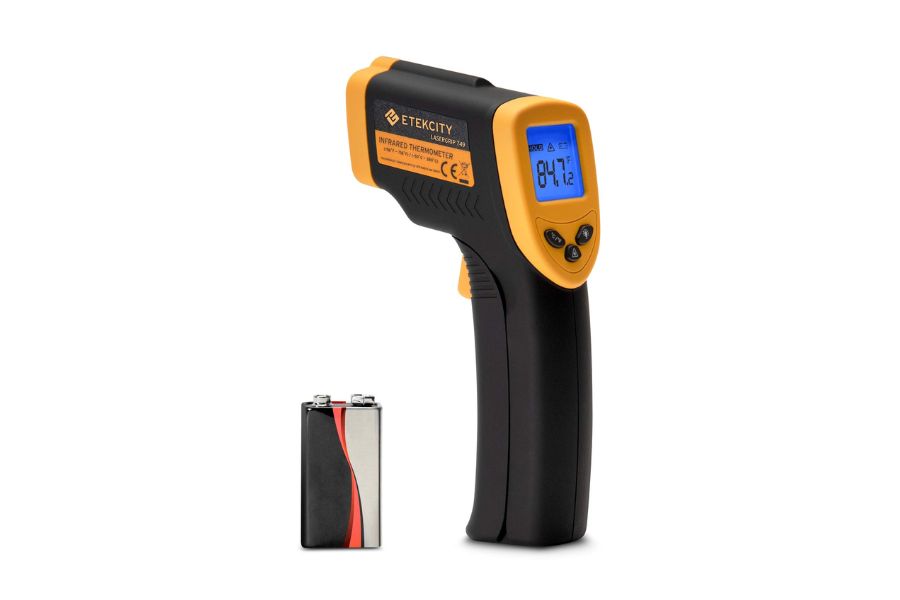
The Etekcity Thermometer excels on pretty much every front. But what we love the most about it is its ergonomic design. Of course, beyond the design, the reading range is impressive, the distance-spot ratio is great, the response time is okay, and the margin of error is decent.
Distance-to-Spot Ratio
With a distance-spot ratio of 12:1, this thermometer is in the midst of the best thermometers in our review. The relatively high D:S ratio affords extra room when measuring temperature.
Margin of Error
This thermometer’s ±2% margin of error is more than decent, especially considering the price. The results with this device will never be far from the correct temperature.
Temperature Range
The Etekcity Thermometer for Cooking offers the joint second-highest range in this review. It can measure between -58 and 1130℉ (-50 and 610℃).
The high measurement range, coupled with the distance-spot ratio, widens the versatility of this device. So, if you ever needed a laser temperature gun for multiple purposes, this could fit the bill.
Response Time
The average response time with this product is around 500ms. So, the result pretty much comes in instantaneously.
Emissivity
Its emissivity can be varied between 0.1 and 1.0. This further increases the number of ways you can use it.
Usage
This product is primarily for household usage – cooking, minor repairs, baking, barbecuing, and the like. But you could also use it for non-domestic purposes if you adjust the emissivity accordingly.
This device is for inanimate objects only. So, do not use it for humans.
Unit Switching
This thermometer measures in Fahrenheit and Celsius.
Other Features
It comes with a brightly lit LCD screen and a comfortable hand grip for easy use.
Budget Laser Infrared Thermometer: KIZEN Infrared Thermometer Gun
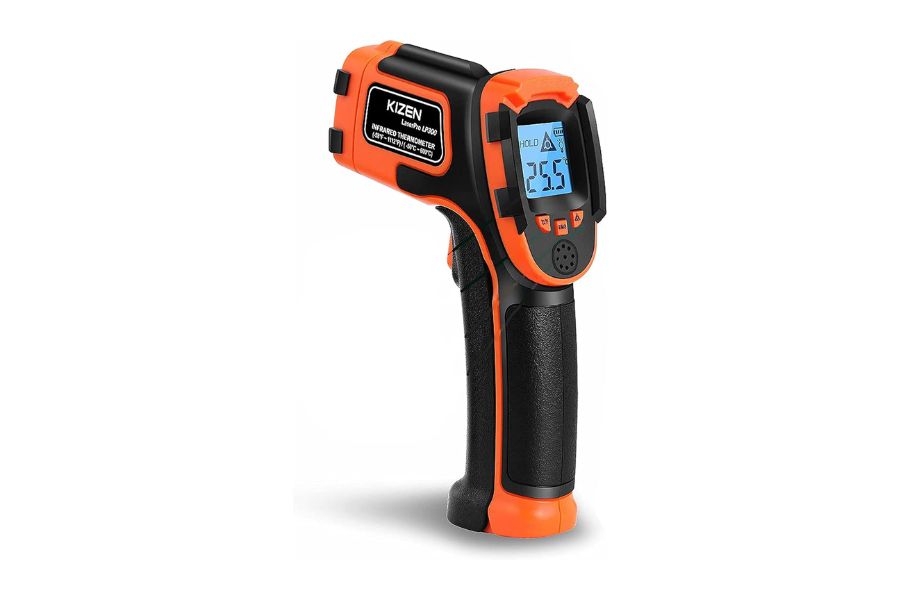
Consider this product if you want a temperature gun that offers accurate temperature measurements, a broad reading range, a good distance-spot ratio, variable emissivity, and rapid response while spending within a budget.
Distance-to-Spot Ratio
The KIZEN has a distance-spot ratio of 12:1 – the same as the best products in our review. With this D:S ratio, you can surely use this thermometer for various non-similar purposes.
Margin of Error
This device has a margin of error of around ±2 – ±2.5%. While this is not far from what many others offer, it could be better. Still, for a budget device, we’ll take it.
Temperature Range
The range of temperature the KIZEN Infrared Thermometer Gun can measure is up there with the best. It can measure between -58ºF and 1112ºF (-50ºC and 600ºC) – only three of the other thermometers in this review offer better.
Response Time
This product’s response time of 500ms is the same as we’ve seen with most infrared thermometers in this review. So, we could just say this device meets the standard response time.
Emissivity
You get adjustable emissivity within the range of 0.1 to 1.0. This allows you to tailor the efficiency with which the target object’s surface emits thermal energy. In essence, according to the target material, you can improve the chances of getting an accurate reading.
Usage
This product is not suitable for use in humans. But you can use it for auto repairs, cooking, HVAC installation, and any inanimate object.
Unit Switching
With this device, you are not stuck with one unit of temperature; you can do things in Celsius and Fahrenheit.
Other Features
It uses a backlit LCD screen. So, you can readily see the output even when it’s dark.
Rapid Temperature Reading: Etekcity Infrared Thermometer 774
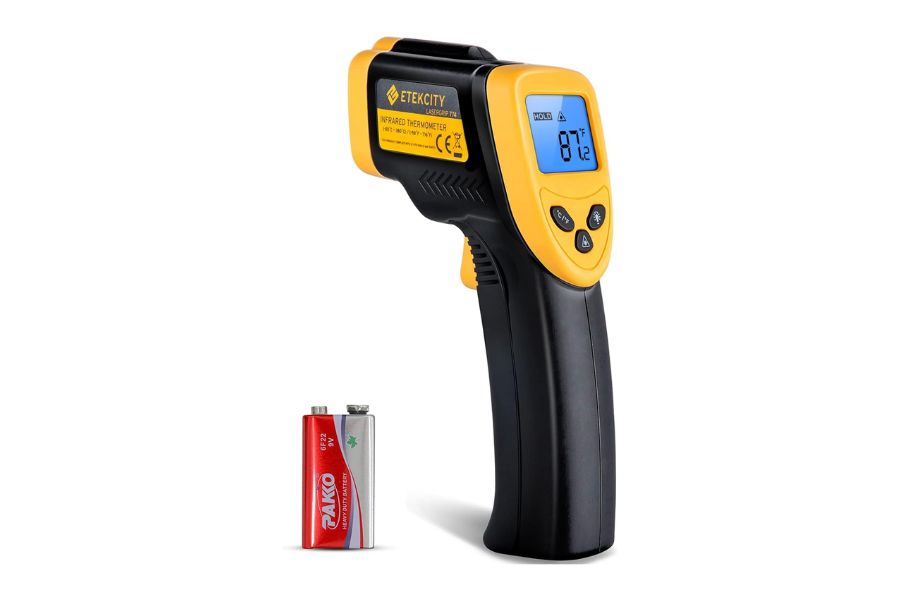
The Etekcity 774 offers one of our review’s top three fastest response times. So, if you need speed, check it out.
Beyond its fast response time, this product has an impressive distance-spot ratio and support for Celsius and Fahrenheit.
Distance-to-Spot Ratio
The distance-spot ratio of 12:1 is impressive as it is up there amongst the best in this review. In fact, none of the products do better than this.
Margin of Error
The margin of error of the device stands at around ±2 – ±2.5%, which is within the alley of all we’ve seen so far.
Temperature Measurement Range
The reading range is not so impressive, but it is still okay. For cooking, baking, testing home appliances, and auto repairs, -58 to 716 ℉ (- 50 to 380 ℃) should suffice.
Response Time
With an average response time of less than 500ms, Etekcity 774 offers some of the fastest result output of most IR thermometers.
Emissivity
This product has a fixed emissivity setting of 0.95. So, it may not be suitable beyond domestic purposes.
Unit Switching
With the Eteckcity 774, there’s unit conversion. So, you do not have to worry about doing the calculation yourself.
Other Features
Like many others, it uses a backlit LCD screen. This makes it readable in various lighting conditions.
Widest Temperature Measuring Range: ennoLogic Temperature Gun
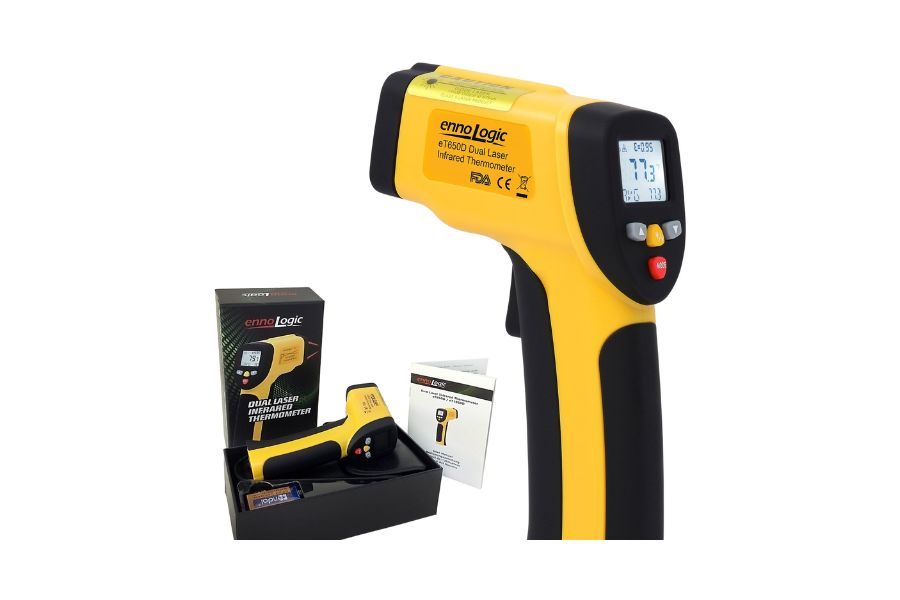
Having the widest margin of error may have chipped some block of its accuracy. But when it comes to response speed, measurement range, and distance-spot ratio, the ennoLogic Temperature Gun excels.
Distance-to-Spot Ratio
While it does not have the highest distance-spot ratio, a D:S ratio of 10:1 is still up there amongst the best. But since the manufacturer primarily recommends it for cooking, the D:S ratio is okay.
Margin of Error
With a margin of error of ±3.5%, the ennoLogic has the lowest accuracy in the review. But since it won’t be used for sensitive readings like human temperature, it’s not too much of a big deal.
Temperature Reading Range
Since it measures between -58 and 1202℉ (-50°C to 650°C), it offers the broadest temperature reading range in this review. So, whether you’re going for a very high-temperature reading capacity or a very low one, this is more likely to fit than the rest.
Response Time
It has a response time of 500ms, which is as swift as we’ve seen in our infrared thermometer reviews so far.
Emissivity
This thermometer comes with adjustable emissivity. So, you can vary emissivity depending on the type of material you are working with. This improves versatility alongside the reading range and D:S ratio.
Usage
This product is primarily for cooking. But then, you may also use it for auto repairs, HVAC installation, plumbing, and other similar purposes.
Unit Switching
You get the option to work in Celsius or Fahrenheit. So, you never have to convert the results manually.
Other Features
The ennoLogic uses dual lasers, so picking out a spot on the target object is less complicated than it would normally be.
Factors to Consider When Buying an Infrared Thermometer
Temperature Measuring Range
The temperature range of your IR thermometer is vital as it affects the possible use cases of the thermometer.
For instance, some gas grills can heat up as high as 1500℉. If your grill plate heats up as high as 1500℉, and you get a thermometer whose upper limit is below 1500℉, you may be unable to use the thermometer with your grill.
Generally, go for products with the widest range. But more specifically, ensure the temp range of your use case falls within that “widest range”.
Distance-To-Spot Ratio
When it comes to the distance-to-spot ratio, go for the highest you can find. A high distance-to-spot ratio leaves less room for variation in the average temperature from the measurement spot.
This means that accuracy is not significantly affected even when measuring the temperature from afar.
Intended Use Case
As you may have noticed in our reviews, not all infrared thermometers are suitable for human use. Then again, if your IR thermometer is ideal for inanimate objects, it may not always be the best for all use cases involving inanimate objects.
So, check that the product you buy is suitable for the use case most important to you.
Accuracy
From impurities to ambient conditions, various factors can significantly affect the accuracy of surface temperature. So, to ensure that even in the presence of these factors, you’re very close to the accurate temperature readings, opt for thermometers with the lowest margin of error.
Typically, you’ll find thermometers with a 2% or 2℃ margin of error. But if you find something even lower, by all means, go for it if it suits you.
Response Time
In most cases, IR thermometers have a rapid response time. In other words, they display results very fast after computing them.
However, to ensure you get a good infrared thermometer, pay attention to the response time value – opt for anything 500ms or lower.
Emissivity
Emissivity is basically a measure of the efficiency with which a body emits thermal energy relative to a black body.
Some IR thermometers can vary their emissivity to ensure high efficiency when measuring temp from certain materials. But others have fixed emissivity, so they are only highly efficient for certain materials.
When buying an IR thermometer, check if the emissivity can be adjusted across a range. This is especially important if you intend to use the thermometer with different materials for a broad range of purposes.
If you intend to use your IR thermometer for just one purpose, a fixed emissivity thermometer would be fine.
Infrared Thermometers FAQs
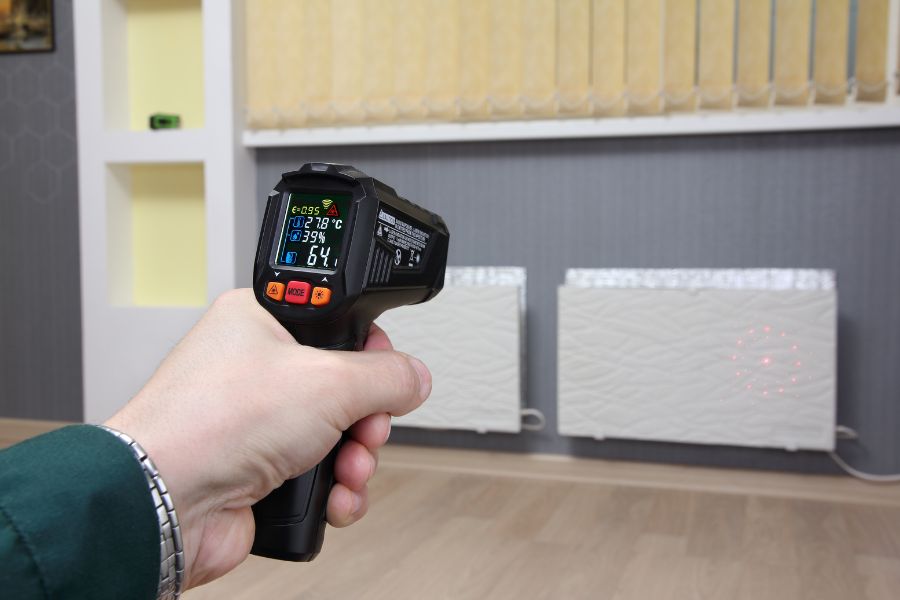
Why Buy an Infrared Thermometer?
There are many advantages to buying digital infrared thermometers, most of which are related to their non-contact feature.
For instance, as a cook, you may buy an infrared thermometer because it allows you to measure the temperature of your cooking surfaces from a safe distance. Besides, measuring surfaces with a thermometer probe is not ideal. So, IR thermometers are pretty much your only option for such use cases.
Another use of an IR thermometer is measuring the temperature of children. Say you’re trying to take the temperature of a sleeping child; raising the child’s armpit may wake the child. So, to avoid that, you can use an infrared thermometer instead of a conventional thermometer.
Infrared thermometers are also useful over a wide temperature range. Also, they give results faster than regular thermometers.
Conversely, a non-contact infrared thermometer may not be as accurate as a contact thermometer. This is especially true if the non-contact infrared thermometer has a low distance-to-spot ratio.
IR thermometers cannot take internal temperature measurements. Also, measuring the surface temperature of shiny surfaces can be an issue for them.
How Does an Infrared Thermometer Work?
The principle behind how an infrared thermometer/laser thermometer measures temperature is pretty simple.
Every object with a temperature emits infrared radiation. So, infrared thermometers measure temperatures by collecting infrared rays emitted by an object.
An infrared/laser thermometer will focus emitted radiation toward its thermopile (interconnected thermocouples that convert heat/infrared energy to electrical energy).
After the thermopile converts the incoming infrared radiation to electricity, the IR thermometer measures the electricity and determines the temperature of the object from the amount of electricity generated.
Measuring temperature by using electricity makes sense since there’s a direct correlation between resistance and temperature.
IR thermometers typically give results within seconds. So, they are pretty handy if you want to collect a lot of temp readings within a short period.
Are Infrared Thermometers Safe?
Infrared thermometers are generally safe when used correctly. Worries about the safety of infrared thermometers are typically linked to the belief that these thermometers emit IR radiation. However, as we’ve explained in the previous subheading, IR thermometers do not emit IR radiation. They just basically measure it.
Also, humans and every other living being emit infrared radiation in the form of heat. So, it is not absolutely harmful.
Another reason people worry about using an infrared thermometer is the laser. Well, the laser in these thermometers is in order to aim at the target object. The output power is minimal, so the chances of it harming you are near zero.
What Temperatures Do Infrared Thermometers Measure?
IR thermometers measure surface temperatures, and their temperature range can be as low as below 0℉ and as high as 10,000℉.
Since the infrared rays that get to them come from the surface of the target objects, the output temperature they show is the object’s surface temperature.
In summary, IR thermometers measure surface temperature but not internal temperature.
When Would a Cook Use an Infrared Thermometer?
A cook may use an infrared thermometer when a probe thermometer is impossible or unsafe. For instance, measuring a cooking pan’s temperature with a probe thermometer is impossible. But you can do this with an infrared thermometer.
Since IR thermometers primarily measure surface temperatures, their use in cooking is limited to measuring the temperature of cooking surfaces. So, while they can measure the temperature of a grill, pan, soup, stew, or oven, they cannot measure doneness.
Can You Check Food’s Internal Temperature for Doneness With an Infrared Thermometer?
The doneness of a food is reflected in its internal temperature. However, since infrared thermometers only measure surface temperatures, they cannot tell doneness.
How Can You Have an Infrared Thermometer Calibrated?
There are a couple of ways to calibrate an infrared thermometer. One of them involves using a black body.
A black body has an emissivity value of almost one. So, it absorbs ambient infrared energy while primarily emitting only its own energy. In other words, most of the IR rays from a black body are not mixed with ambient IR energy. This makes for high accuracy. Hence, its use in infrared thermometer calibration.
Besides a black body, you can also use an infrared comparator cup or an ice bath to calibrate your infrared thermometer.
Calibrating an Infrared Thermometer Using a Comparator Cup
You’ll need a reference thermometer to calibrate an infrared thermometer with a comparator cup. The reference/master thermometer is typically a probe.
Once you have the comparator cup, master thermometer, and the infrared thermometer, follow these steps:
- Ensure the room temperature is around 22℃ (71℉). Calibrations done at this temperature are typically more accurate.
- Ensure the comparator cup, master thermometer, and infrared thermometer are free of dirt, debris, and any other thing that can influence the readings.
- Insert the reference thermometer in the comparator cup and leave it to stabilize the temperature inside the cup. This could take time, depending on the sensitivity and response of the reference thermometer. But typically, a few seconds or minutes should do.
- If the IR thermometer has adjustable emissivity, set it to 0.95. Then, once the reference thermometer is stabilized, hold the IR thermometer above the cup and point it straight down into the bottom of the cup. Then, take a temperature measurement.
- Record the readings of the reference thermometer and the IR thermometer. Then compare.
- The difference between the readings from both thermometers should be no more than 1℃ (33.8℉).
Calibrating an Infrared Thermometer Using an Ice Bath
- Prepare an ice bath by filling a glass to the brim with ice (preferably crushed ice for more surface area) and adding very cold water to a level just below the ice.
- Stir the bath for a few seconds to create an even temperature.
- Tamp the glass by the side to create a well of water at the top (ensure no ice is floating).
- Adjust the emissivity of your infrared temperature gun to 0.95 or 0.97.
- Hold the IR thermometer above the ice bath, so that its lens points directly to the surface of the ice bath.
- Take a temperature measurement.
- The difference between the result and 32℉ should be within the accuracy specification for your device.

